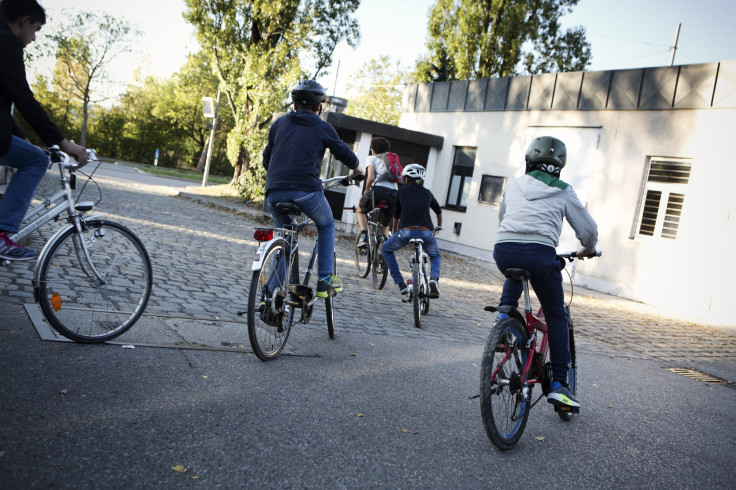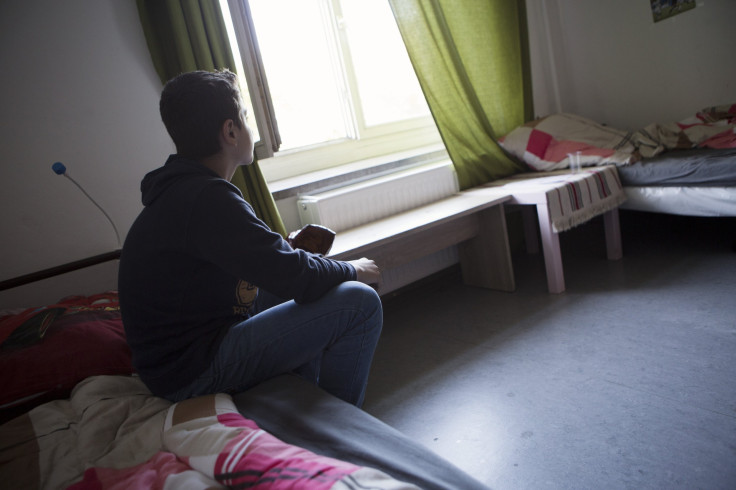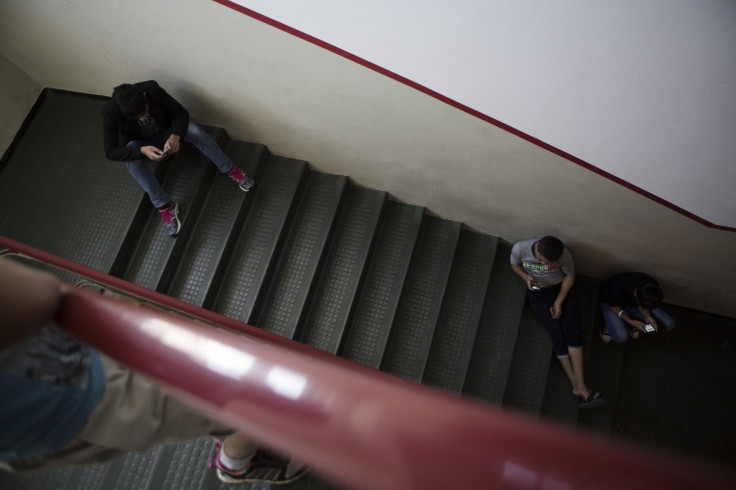Overwhelmed By Thousands Of Refugee Children Traveling Alone, Europe Considers Adoption
In 2015, the most unaccompanied kids in six years are likely to enter Germany. Adoption is one solution — but not all refugees want to be adopted.

MUNICH -- In a yellow, concrete dorm building for refugee children located just outside the city center, there's a room at the end of a long, dark hallway. A group of children, ages 7 to 16, huddle in the doorway, peering in at its exotic content: a pool table. Inside, children wield cues, slapping balls wildly across the green felt table, betting candy bars on the outcome of the games.
For these refugee children, pool is an unknown -- but welcome -- distraction from painful memories of their lives before they landed in Germany, leaving behind homes in the war-torn states of Syria, Afghanistan, Eritrea and Sudan. The game has become a way to pass the time amid hours of sitting in stairwells and playing on their phones or lying on their beds in their rooms waiting for the next meal.
But that lone diversion is slated to disappear. The pool table was set to be removed to make space for more children -- a minor accommodation that speaks to the crisis sweeping Europe. As a torrent of refugees reaches its shores, there remains variations of the same basic question: What should they do with all these young people?
“We just don’t have the capacity to look after them all.”
Last year, 24,000 unaccompanied minors -- children traveling without a parent -- applied for asylum in the European Union. This year, the numbers are likely to be much higher, according to a recent report by the Organization for Economic Cooperation and Development. Estimates by international aid organizations suggested that between 4 and 7 percent of the approximately 700,000 asylum applications made in 2015 came from unaccompanied minors. So many have arrived on the shores of Greece that the international aid organization Save the Children told International Business Times that they have no way of tracking them all.
This home in Munich is already at full capacity. The children have to eat in shifts, share rooms with more than 10 others and take turns on bicycles in the basement. Public services are also limited: A couple of volunteer teachers and a single doctor serve the 95 children who reside there.
Aside from the occasional group activity or German class, the teenagers largely are left to fend for themselves. And while the accommodation is clean and residents are given three meals a day, children go missing “almost on a daily basis,” Eva Ramsauer, the home’s psychologist, said.
“We just don’t have the capacity to look after them all.”

Despite its failings, Ramsauer says the home is one of the better ones in Europe. “We really are very lucky here,” she told IBT. “This [building] was just redone and is much better than other homes in the region.”
Since January, more than 6,000 children have made their way to Germany without parents, and hundreds more are arriving every month, officials say. This year, Germany is likely to see the largest number of unaccompanied minors entering its borders in six years. In 2014, Germany registered over 11,500 unaccompanied minors, according to government figures. This was an increase of 5,000 from the previous year and six times the number recorded in 2009.
As the number of unaccompanied minors increases across Europe, governments are discussing new ways of responding to the crisis to ease the steep costs of housing them. One suggestion was to fast-track refugee children into the foster and adoption systems. In Germany, officials said the government has already started processing some unaccompanied minors for adoption.
“The majority [of the children] were sent here alone by their parents,” said Ramsauer. “In Germany, the legal perspective is once the minor is sent away, the parents give up their rights. So I think in Germany, as soon as they arrive here, they are able to be adopted.”
But many of the children at the home in Munich have parents back home that they talk to everyday. They aren’t looking for new families.

Ali Hassan Ali’s story is typical. The 14-year-old from Idlib, Syria, made the journey to Germany with three teenage friends. His parents are still in Idlib, looking after his three younger siblings. He left home in June but still talks to to his family daily and keeps pictures of them on his phone.
He doesn’t want to be adopted, he said. “[My parents] wanted me to come here first and get some schooling. There is no class in Syria. My school was hit by bombs. God willing, the rest of my family will come next year.”
Ramsauer said the majority of the kids in the home were smuggled to Germany, and though many were sent by their parents to pursue an education and a residency permit that would allow their families to follow, others have no parents and make the trip voluntarily.
Some of the children in the home leave for other European countries to avoid adoption or being moved to a different house. And the staffers at the home in Munich encourage them.
“When they tell us that they have family in Denmark and they want to go, we suggest [they] find a way to leave because if they get stuck with us here, it takes ages,” she said. “Usually if [the kids] find out it is hard to get the transfer, they just disappear and hopefully turn up at the place they want to [go].”
“[My parents] wanted me to come here first and get some schooling. There is no class in Syria. My school was hit by bombs. God willing, the rest of my family will come next year.”
Hundreds of unaccompanied minors have been arriving in Germany each month, eschewing eastern European countries that they passed through first because conditions are often much worse.
A children’s home in Fot, Hungary, has been in crisis mode for the last four months. The home was flooded with refugee children, most of them in their teens, and the home's employees are unable to provide basic services for the newcomers. Children sleep on mattresses in hallways, food is scarce, and there are no translators for the mostly Arabic-speaking children. It takes weeks to register youngsters with local authorities and submit their applications for asylum.
Some of these children inevitably appear in Germany -- many times under different names -- and start the lengthy asylum application process all over again.
In the meantime, children in the home in Munich sit and wait, wondering if they will be transferred out of the home or end up with a new family.
Homes Seeking Children
Some 4,500 miles away, word has gotten out about the unaccompanied minors in Europe. There are couples looking to adopt refugee children.
In Spokane, Wash., Dan Wilcox, 43, switches on his television. The news station is airing another segment about the refugee crisis in Europe. The camera pans across crowds of people waiting in train stations in Hungary, desperately trying to get to Germany. Some of the refugees look like little more than teenagers, and many seem to be traveling alone. Maybe, he thinks, there is one that needs a home – perhaps his home.
“It just seems criminal that we would have to pay so much money or that it would take getting around that much red tape to help a kid in that situation,” Wilcox said of the process of adopting a refugee child.
But adopting an unaccompanied minor is difficult because of the barriers governments have built following a series of scandals in the 1970s and 1980s.
In 1974, “Operation Babylift” commenced with a series of highly publicized humanitarian rescue operations that brought at least 2,000 Vietnamese children to the U.S. for adoption. In 1989 -- with the fall of the Soviet Union -- Americans, along with other Western couples, went to Romania seeking to adopt children there. Several years later, the media revealed that the Romanian orphanages were filled with neglected children, many of whom who had severe emotional and physical debilities. In China and India, children were kidnapped from their parents and sold on a lucrative black market.
“If children are exported to the U.S. for money, it is a type of trafficking,” said Arun Dohle, executive director of Against Child Trafficking, an organization working to prevent trafficking through international adoption.
Child rights advocates have reached out to the European Commission to flag the developments in Germany, fearing that children who have been trafficked to Europe or who have families in their country of origin will be put up for adoption -- a scenario they and adoption agencies in the U.S. say is not healthy for the child and encourages illicit activities.
“The child should always be connected in some way to their country of origin, their heritage,” said Julie Snyder, director of communication for the World Association for Children and Parents, an international adoption agency in Washington state.
Elisabet Purve, now in her 40s, was adopted from India by a Swedish couple in the 1970s when she was 2 years old. It was only this summer that she finally met her birth mother, but she still doesn’t know why she was given up for adoption.
“All of the other people around me were white. There weren’t many immigrants in the country at that time,” she said. “I was unlike everyone else. I wanted to know who I was. I had this strong urge inside me.”
Purve contacted Dohle at Against Child Trafficking, an organization that solves adoption cases and reconnects adoptees to their birth parents. She traveled to India last month to connect with her birth mother.
“She is so beautiful,” Purve said. “When I had to leave her, she picked up a part of her sari and wiped away my tears. That love and comfort I felt with her then is something I didn’t feel throughout my entire life with my mother in Sweden.”
“The child should always be connected in some way to their country of origin, their heritage.”
Staffers inside the children’s home in Munich say that children are never put up for adoption against their will, but with increasing pressure to cut costs, child rights activists worry international standards will be pushed to one side. Even the children in the home are unsure where they will end up. They could be transferred to another temporary refugee home, into a foster home or put up for adoption.
Children Far From Home
As officials in Berlin process unaccompanied minors into the national foster care and adoption systems, the children in Munich -- if they stay in the home -- learn German and establish lives in a new country. For many children, especially the younger ones (who are as young as 7 years old), day-to-day life is structured by intermittent group activities and German classes, but the kids say they often feel trapped because they can’t leave the compound without a guardian.
Considering how many children live in the home, the building and outside play area are preternaturally quiet. That’s because the youngsters speak a host of different languages, including Dari, Arabic, Tigrinya, some German and English. Communicating verbally is almost impossible. Instead, the 95 children at the home use hand gestures.
Outside the children’s house, in the cement lot, Mustafa, a 10-year-old boy from Afghanistan, walks up to a friend of his from Syria watching an impromptu soccer match. Mustafa lightly pats him on the cheek. “Hello, hello, I’m Mustafa,” he says in English -- the only phrase he knows.

Several of the children sit in plastic chairs, some listening to music with their earphones, others talking with one another. Another boy, this one from Afghanistan, stands up and kicks Ali Hassan Ali in the leg, taunting him to get up from his seat and fight.
Ali stands against the house’s brick wall, eating a bag of chips. The boy from Afghanistan, who is 15, puts his left hand against the wall next to Ali’s head and lifts the other above his head in a fist, as though he’s going to punch Ali.
“This is how we fight in Afghanistan,” the boy says.
A volunteer, a German girl, stops the fight, pulling the two apart. The boy from Afghanistan steps back, then shuffles his feet back and forth while throwing punches in the air.
The reaction from the Afghan boy is not uncommon in the home. Staffers say the majority of unaccompanied minors, many from war-torn countries, have psychological problems, including severe post-traumatic stress disorder. Although they have weekly doctor’s checkups, the staff does not have enough time to give each child the psychological counseling he or she deserves, Ramsauer, the psychologist in the home, said.
Ali walks away from the Afghan boy and sits down at a round, wooden table. He flips open his new German language workbook and attempts to tackle the fill-in-the-blank grammar section in chapter two. He covers his ears with both of his hands and tries to drown out the noise of the rambunctious boys playing soccer behind him. Out of almost 100 children, Ali is the only one studying, but after a few minutes, he is up on his feet and joining in the activities.
A soccer ball skims by his feet, and he jumps into the game, dodging Munich teens that are passing through to reach the metro station on the other side.
The complex at the children’s home has little security.
The front doors at the children’s home are manned by two men, staff workers that act as security officers. They open the door when someone rings the bell and point them in the direction of the main office. Only the unaccompanied minors that stay in the home need to show their identification.

Inside the accommodation block, dozens of teenagers line the main stairwell, sitting on the stairs and sending messages to friends on their mobile phones. Children run in and out of the front doors directly past the security guards, staffers shuffle from office to office and the cooks prepare dinner in the cafeteria.
A ping pong table sits in the center of the complex on the first floor and divides the boys’ section of the house into two different wings. The first floor also has a small classroom, a lunch area and a doctor’s office. The girls sleep upstairs.
Each bedroom is assembled with at least four different metal bunk beds, each set decorated with paper cut-outs and posters from magazines, as well as pictures of family. All of the beds are unmade, sheets draped off of the mattresses.
Ali runs into his room to find the three friends he traveled with from Syria.
The walls around his bed are filled with memories of home -- pictures of family and Syrian flags drawn on scratch paper with crayon.
The urban view from the window is worlds away from the one he had back home. There, he had two horses he rode almost every day on his family farm.
He points to a photo of his mother. She is squatting next to him with her arms draped around his shoulders. “That’s mama,” he says. He sends her a short message on WhatsApp: “I miss you,” it says.
Ali tries to keep his promises to his family by learning German and staying active.
He joins his friends in the basement, where the children have been fixing old, broken bicycles.
One of the main staff members picks Ali and his friends, along with 10 other children, for the test ride. As they ride out of the complex, a woman takes a photograph of them.
A 15-year-old boy from Afghanistan walks up to her and asks for a copy of the picture. “I’m leaving tomorrow; can I get that?” he says.
“I don’t know where I'm headed, but I won’t be able to get a hold of it.”
© Copyright IBTimes 2025. All rights reserved.





















